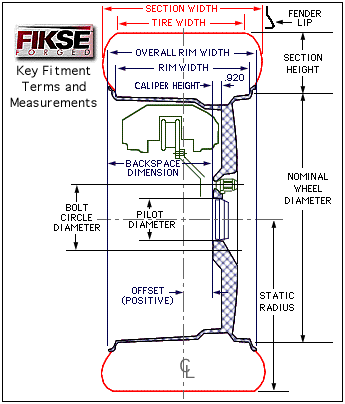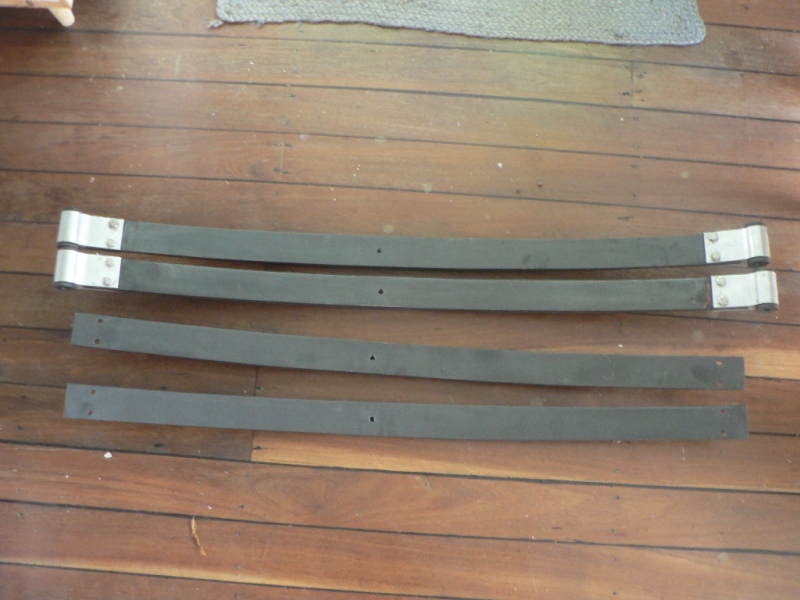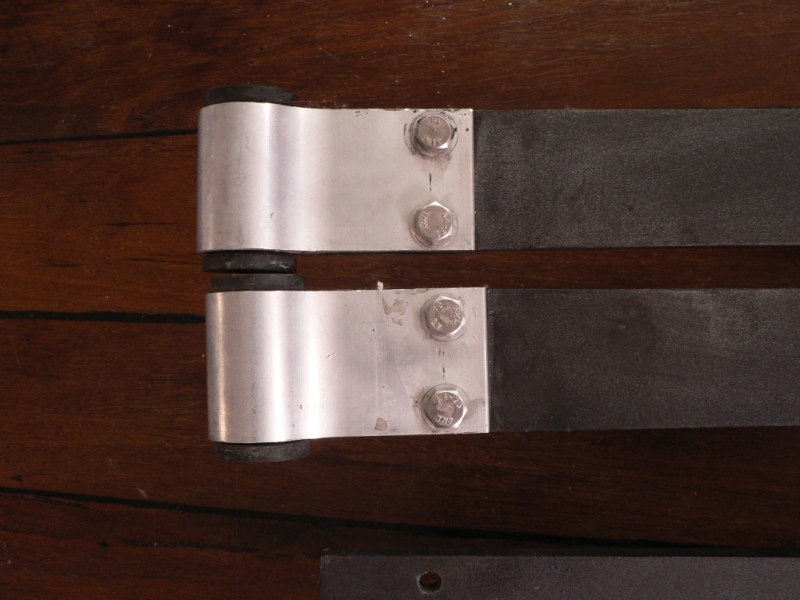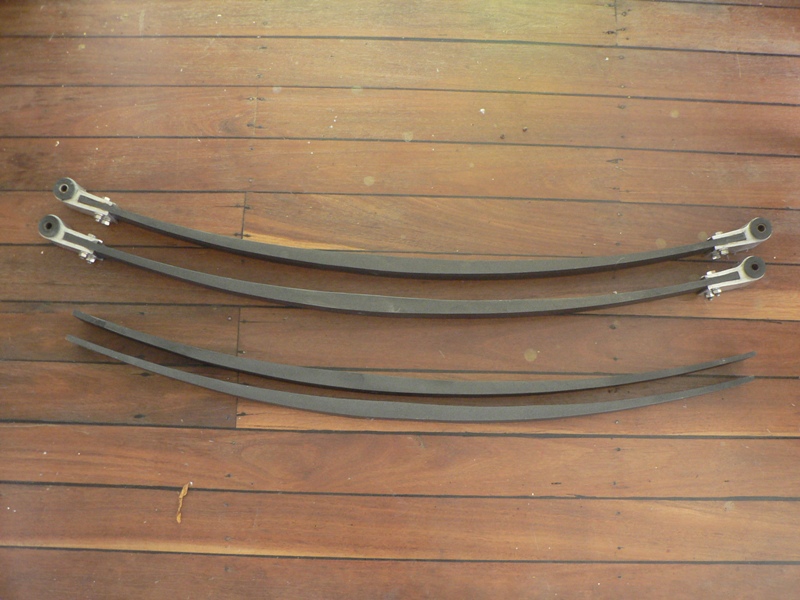Your First Suspension Upgrade
B210 Sway Bar Upgrade
Bolt a B210 (1974-1978 Sunny) swaybar on. For around $20 and an hour of your time, it bolts in without any mods:
what a difference it makes I can't believe the difference I can finally go around corners at a decent speed.For anyone who's looking for a quick and cheap handling improvement this is the way to go.
See main article: B210 Sway Bar Upgrade
Competition Suspension Manual
See Datsun 1200 Competition Suspension Manual
Handling versus Roadholding
Handling is the quality of the car during dynamic changes: how it reacts while cornering, how it responds to sudden changes of direction, what happens as you approach (or exceed) the limit of cornering speed, etc.
Roadholding is more concerned with grip. Some cars grip smooth pavement exceptionally well, but their handling manners are not great. For example, they can corner extremely fast, but may be twitchy, prone to oversteer, be unstable over bumps or have other serious faults. Interestingly, the best modern factory cars will pull 1.00g, e.g. Corvette, Porsche 911 GT, etc. More average modern sedans pull about 0.65g (these numbers vary by the diameter of the testing circle, so don't be too concerned about ratings). You can use a G-Timer (about $200 USD) to test g-forces of your car.
Handling is probably the more important factor for a street car. You want a car that handles safely under all conditions and is predictable.
For more information, see the "General Handling" section towards the end of the Datsun 1200 Competition Suspension Manual.
With such a light-weight car as the 1200, it is difficult to improve handling without reducing the ride quality. For a circa 1970 automobile, the 1200 has very good handling (e.g. better than most period 'muscle cars'), but it doesn't compare well to modern suspension technology. Unfortunately, most of the handling improvements will make your 1200 ride rougher than stock.
Stock Suspension
The stock 1200 suspension will give you the smoothest ride, with reasonably good handling characteristics. It sits surprisingly high, which is good for off-roading, but not optimum for cornering on pavement. However, if you lower it, you'll get a rougher ride. The McPherson struts provide the damping force for the front suspension, are surprisingly smooth if in good condition. The rear shocks however, having to damp the relative heft of a live axle suspension, ride fairly rough. That's just normal for light cars without Independent Rear Suspension (IRS).
If you don't want a rougher-riding car, stick with the factory suspension. Just make sure all the steering linkage is in good condition:
- Steering Gearbox Adjustment to take play out of the steering. Do this first.
- Ball joints: If they are loose, replacements are available just about anywhere
- Idler arm: NAPA, or any store sells bushing replacement kits which is OK if the ball end is not worn (loose)
- Drag link
- Pitman arm as a ball end that can wear
Also:
- sway bar bushings. make sure the bar is tight in the brackets. Replace the bushings as necessary. Also, make sure the side of the bar with factory white paint mark is installed on the left side of the vehicle
- tire size is 155SR-12
- Optional radials versus standard bias-ply? The factory optional radial tires are the go. They track straighter, last longer, and are more available. Bias-ply tires do often feel smoother though.
- Wheel offset. Keep it stock to avoid scrub problems (more details below)
- Tire pressure: 24 psi. Higher pressures will create a rougher ride, and will wear out the center of the tire tread
- Tire profile. The default 78 or 80 series (tall profile) is the smoothest. Low profile 70, 60, 50 or lower profile tires increasing become harsh riding
Also keep the rear suspension in good shape. The low-friction material between the leafs should be cared for (see the excellent discussion Leaf spring ride quality).
And lastly, good shocks are a must. Push down on each corner of the car, and let up suddenly. The car should bounce only 1 time. If it bounces multiple times, replace the shocks. Note that "gas-charged" shocks and struts will ride rougher than the stock parts. The gas-charging firms up the suspension, hence their popularity with large sedans that start with a 'wallowing' ride quality. Since the 1200 already has a firm suspension they will just make it ride rougher. This may be useful for racing, but not if you value a smooth street ride.
Using a factory-quality Strut rebuild kit (rather than removing the factory strut parts and replacing with a new strut 'cartridge' insert) is the way to retain a smooth front-end ride. On the rear, the factory shocks are the smoothest, though 'adjustable' shocks may work just as well if you can find them. Factory B210 shocks also fit and have similar damping quality. Aftermarket struts inserts and rear shocks are generally firmer.
Modified Suspension
Modifying the suspension for increased handling and roadholding traditionally takes this course:
- Camber adjustment modifications -- increased camber & adjustability
- Increased caster -- for better on-center feel and less wandering
- Adjustable ride height (for race cars)
- Lower center of gravity -- The stock front springs are replaced with stiffer, shorter units. The rear leaf is eye-reversed or reverse cambered. 2-inches is a common drop
- Improved brakes -- The stock 1200 brakes are discarded and the struts replaced or modified to accept larger discs and calipers
- Roll stiffness -- Replace the stock bushings with stiffer parts, use stiffer springs, and fit heavier sway bars
- wider, lower-profile tires for increased traction
For off-road rallying:
You may want to go to slightly heavier springs in the front...it wouldn't hurt to even lift the front slightly, it helps out with ground clearance. Making the bottom arms longer will give you more negative camber and at the same time more +ve castor...both a good thing. The rear needs more work. I have always set mine up to be soft in the rear. This gives more weight transfer onto the back resulting in better traction. You need to take that extra leaf out and don't make the shocks too hard.2 top links mounted forward help to locate the diff and prevent axle tramp. This is a good basic setup and can be done at minimal cost. These cars do handle better on gravel with the back being lower than the front. You also need to set your brakes up so that there is more bias on the back than the front...this helps to prevent sledging (caused by the front brakes locking up and preventing steering), and lets you set the tail of the car up into corners by locking the rear brakes first. reference
What about Polyurethane Bushings?
Road racers like polyurethane bushings (Delrin, Nolathane or Softride (NOLTEC's brand name), these can be rough on the driver and the car, but make it handle better by reducing the "give" in the bushings. This results in quicker turn-in and more consistent response to varying suspension road forces. You may be able to find firmer rubber bushings, which are a good compromise between smooth ride and best handling.
references:
- discussion
- old discussion
- NOLOTHANE discussion
- Front spring eye bushing on rear leaf spring
- Search the forums for Delrin or Nolathane
Tires and Wheels
Wider Tires?
Wider tires help the roadholding a lot. The downside of wider tires is that fuel economy will decrease due to the higher friction of wider tires.
Adding wider tires to the rear (175mm wide to 205mm wide) will help powering out of corners. 205 is the widest that fits under the stock 1200 rear but you'll be hard pressed to find wheels with the right offset to accomplish this. Wheels with positive offset (fwd-style wheels) and spacers can be used.
Wider tires on the front will help reduce "push" (understeer) going into corners. Push is the tendency to slide off the road toward the outside of the corner. Note that most cars, including the 1200, are designed for some understeer because that's safer than oversteer (which carries the risk of spinning-out). The downside of wider front tires is that steering effort increases. 185mm wide tires (e.g. 185/60-R13) fits under stock front. Just keep the wheel offset reasonable.
With wider tires, the diameter gets larger, which has negative effects: The ride height increases, the speedometer reading changes, etc. But using wider, but lower profile tires can keep the diameter near stock.
Wheels that fit the 1200
To choose the kind of wheels you want, see:
Tire Scrub and Wheel Offset
Too much scrub makes the car a bit unstable under braking and therefore won't generate quite as much cornering grip.
This applies mostly to the front suspension (due to the kingpin inclination angle) and not so much to the rear (where camber is nominally zero due to the live-axle design).
Since this affects handling, you'll want to review:
Tires
Stock wheels use 155SR-12 (155 mm tread width) on a 4" wide wheel. These are optimum for fuel economy as they have low friction.
For information on choosing taller, bigger or wider tires, see: Tire Sizes.
Steering and Alignment
Steering Gearbox and linkage
The complete steering linkage is adequate for competition purposes. This includes the steering gear box, tie rods, tie rod ends, all steering arms, idler arm assembly and the lower ball joint.
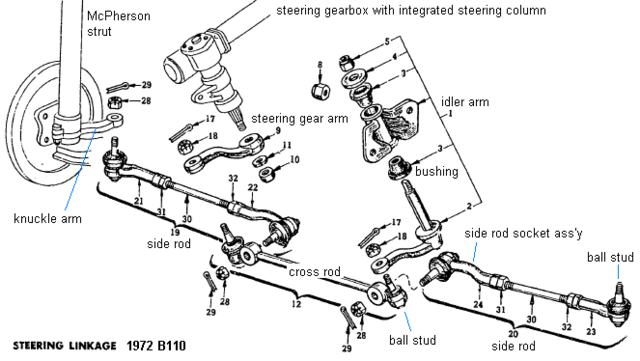
The B110 (1971-1973) gearbox is connected directly to the steering column. B210 (1974-1978) and B310 (1979-1982) box is separate, and uses a rag joint (flexible coupling) to connect to the column.
When the gearbox gets to be about 15 years old, it wears enough to introduce slop into the steering linkage. A simple adjustment will often remove this play. If your gearbox is worn too much to adjust, replace it with a good used or rebuilt unit. See Steering Gearbox Adjustment.
Quick-Ratio Steering
Modifying the steering linkage for a faster ratio makes the car respond quicker to steering input. And you won't have to turn the wheel as far to turn a given amount. With the light front end of a 1200, and thus super-light steering effort, a quicker ratio will not be a problem.
- You can shorten the pitman arm and idler arm (have a professional welder do it) to gain a quicker steering ratio
- Rumor has it you can fit the later boxes to the B110 and gain a quicker ratio
- Rumor has it that corolla arms can be used on a B110
reference: all new steering for the 1200
For a Rally Car:
the front suspension needs plenty of castor....you will have to cut a bit out of the bottom of the front guards to give the wheels clearance but it is well worth it.The steering will be heavier when driving slowly but much better feel when you get moving. I also used early model Corolla steering arms (KE20 or 25 I think) which are much shorter than the Datsun ones, this gives a much better lock and "gears up" the steering. I used the standard sway bar on the front and nothing on the rear for gravel, but used a small bar on the rear for Seal [paved road]. reference
Wheel Alignment
The stock wheel alignment settings for Camber, Caster and Toe-in are very old-fashioned, designed for old roads with crowned road surfaces. Modern cars--even stodgy family sedans--now use negative camber for increased roadholding on flat roads.
For stock settings, see Front Suspension Specification.
-VE Camber (Negative camber)
1.5 degrees negative camber can work well for racing.
See main article: Camber
Increased Caster
More caster will improve on-center "feel" and make the car track better. In other words, it will go straight ahead with hands off wheel.
See main article: Castor
Lowering Springs
Lowering the car makes it handle transitions better. A common way to achieve this is:
- Fit ready-made lowering front coil springs
- Re-arch the rear leaf springs (or fit lowering blocks).
For details on this and much more advanced lowering methods, see: Lowering.
Rear Suspension
B110 and B210 both use a leaf-spring rear suspension and a live axle. By contrast, the B310 uses coil-springs on a live axle.
The B110 has the advantage of a light-weight axle assembly using the small H145 differential and this is recommended for all A-series race cars (Nissan Competition only sold LSD units for the H145). The B210 and B310 use a slightly heavier but stronger H150 differential. Lighter is generally better for handling and ride quality, but the H145 only handles about 75 lb-ft of torque, so if you have a larger engine (A15 or larger) then using a larger differential is called for. For more details, see Rear Axle Swaps.
Smooth ride
The stock Datsun 1200 rear suspension rides rough. It tends to bounce on uneven pavement. This is normal due to the stiff springs. Here are some ideas to help improve ride quality:
- Keep the stock ride height, so that you get the full movement of the shocks
- Replacing the stock leaves with a fibreglas monoleaf may help with the ride quality (and improve handling simultaneously).
- Repair the low-friction material between the leaves. See Main Forum discussion POST Leaf spring ride quality
- New rubbing blocks are sold by spring shoppes or online, not the exact Datsun designs, but similar or in full strips out of poly/vinyl or Teflon
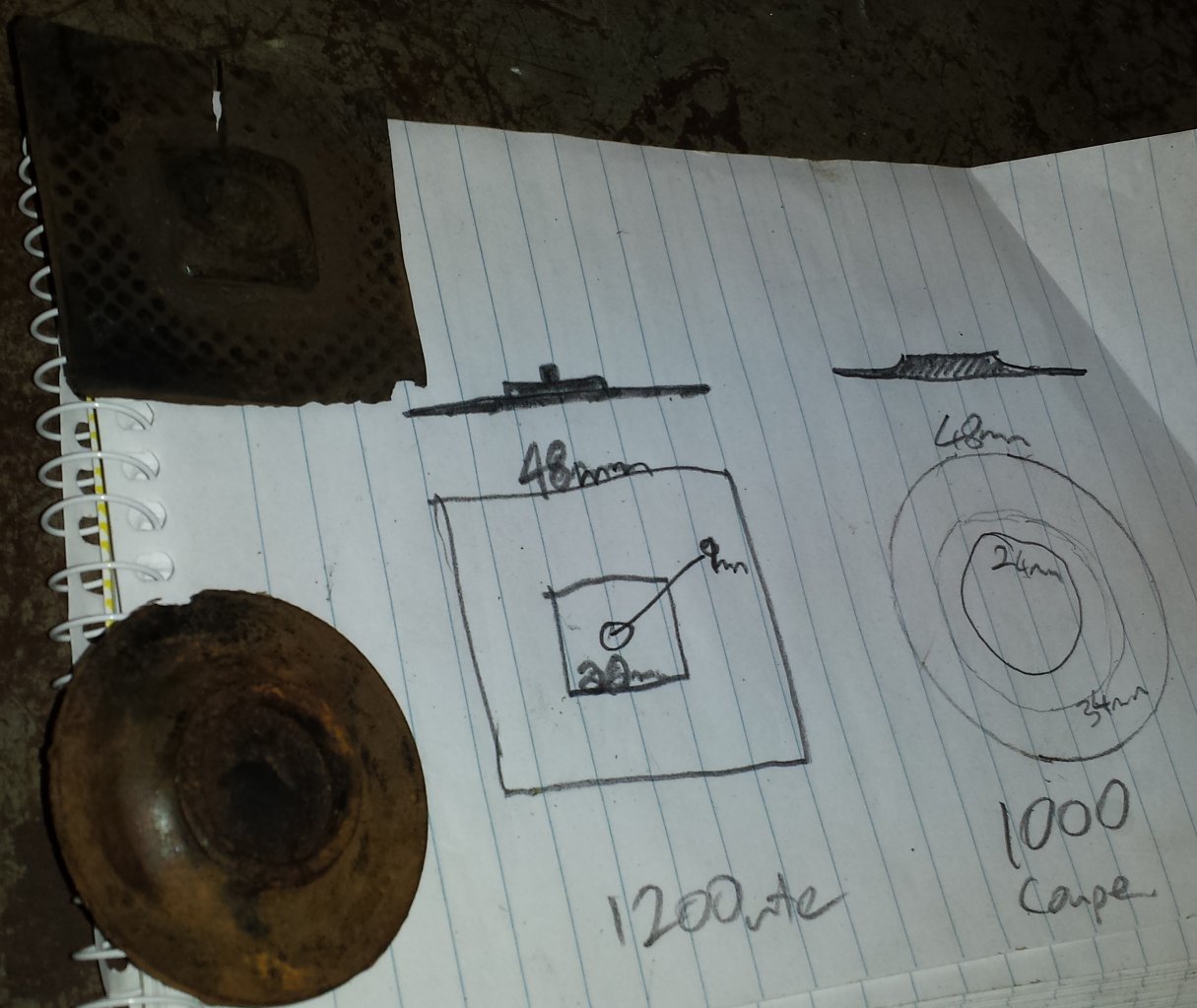
- New rubbing blocks are sold by spring shoppes or online, not the exact Datsun designs, but similar or in full strips out of poly/vinyl or Teflon
- get new springs made that have a lower spring rate. However, this limits your load-carry capacity (not so good if you carry back-seat passengers)
- remove the bottom leaf of the spring pack. Again, while this smooths the ride, it reduces cargo capacity
- carry lots of weight in the back of the car. This dramatically smooths the ride, and won't hurt freeway fuel economy, but will reduce city fuel economy since you'll be accelerating extra weight
- Do not use gas shocks.
fiberglass monoleaf springs
Crisper Handling
Crisper handling is generally achieved by lowering the rear and firming up the bushings. For details, see Lowering.
Here are some ideas that can be used with or without lowering:
- Stiffen leaf pack by swapping individual leaves from a B210 (the main spring is slightly different)
- Get new springs made to your specifications (A good spring company or suspension man will advise on the proper specs for your intended use)
- Reduce the side-to-side movement of the axle during cornering
- Stiffer leaf spring bushings for the leaf eyes are quite effective
- A Panhard Rod, but be careful if not done correct can cause binding and make the suspension worse. Better yet is a Watt's Linkage.
- Staggered shocks. Coupes have the advantage here since their shocks lean in different directions to counteract the torque of the axle. Sedan shocks are straight up and down
- Reduce Axle tramp on hard acceleration. Though not generally a problem with a stock A12, with more torque or high-rpm clutch-dumping launches it becomes a problem
- traction bars
- traction arm. See the Datsun 1200 Competition Suspension Manual
- half-leaves
| rear leaf | B110 | 1977 US B210 |
| dimensions (length x width x thickness) | 1110 x 50 x 6 (1 leaf) | 1165 x 50 x 6 (2 leaves) |
| additional leafs | 1110 x 50 x 7 (2 leaves) | 1165 x 50 x 7 (2 leaves) |
| Spring constant | 1.96 kg/mm (109 lb/in) | ? |
| Laden camber | 11mm/192kg | 31mm/219kg |
| Spring eye diameter front | 35mm | ? |
| Spring eye diameter rear | 23mm | ? |
| shocks (sedan) | 167mm stroke x 506 length | 205mm stroke x 527 length |
| shocks (coupe) | 180mm stroke x 440 length | 195mm stroke x 470mm length |
| Damping force expansion | 58kg (sedan) 68kg (coupe) | 44-68kg@0.3m/s |
| Damping force compression | 38 (sedan) 45(coupe) | 26-42kg@0.3m/s |
Rear Sway Bar
Although 1200s did not come with rear sway bars, Nissan Competition sold a bolt-on rear sway bar. Search the main forum for details on adding a rear sway bar (a.k.a.anti-sway bar aka stabilizer bar).
Sway Bars| part | B110 | B210 | Nissan Comp | Quickor |
| front | 17mm | 20mm | 20mm (PN 54611-H2300) | 25mm (PN 99996-H4301) |
| rear | n/a | n/a | n/a | 19mm (PN 99996-H4351) |
Chassis Stiffening
See: * Tower bar strut bar * Seam welding * Rollcage * Steering Gearbox Brace
Advanced Suspension Designs
front control arm mounting points moved way up

A lot could be talked about here. Search the Main Forum for discussions on:
- four-link suspension
- three-link suspension
- five-link suspension
- IRS (independent rear suspension) conversions have been done to several 1200s and B210s
- tubbed rear and narrowed axle (to get monster tires on the back)
- hand brake modifications for racing
- adjustable ride height
- Fender flares for wider tires
Search the forums for copious details on these topics.
More Information & References
- Suspension And Brake Swaps
- Datsun 1200 Competition Suspension Manual
- 1984 Nissan Competition Catalog
- Forum discussion: I want it to turn on a dime and give 9 cents change!

![[Datsun 1200 encyclopedia]](/wiki/upload/wiki.png)


